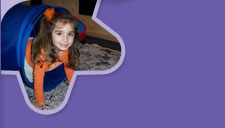A child may need to be evaluated if difficulties are seen in one of these five areas or if one area causes major functional problems:
- Overly Responsive to Sensations
- Under Responsive to Sensations
- Inefficient Perception of Sensations
- Difficulties With Motor Planning or Praxis
- Difficulties Efficiently Processing the
Vestibular System (Balance and Movement)
Overly Responsive To Sensations
Some children have a "fight or flight" response to sensations not typically bothersome to children the same age. Below are some examples:
- Aversion to or withdrawal from touch or textures:
- Unusual dislike of bathing, face or hair washing, haircuts or nail cutting
- Tendency to avoid physical contact, becomes tense when held
- Agitated by unexpected light touch
- Dislikes contact with sand, dough, glue or finger paint
- Overreacts to getting dressed or to certain textures of clothing
- Greater than expected sensitivity to sound, odors, tastes, or lights:
- Covers ears around specific sounds, unable to tolerate a movie theater
- Very picky eater
- Gags in response to odors that are typically non-noxious
- Expresses discomfort or “zones out” in loud or busy environments like sporting events, malls, crowded streets, birthday parties, loud classrooms or family events
- Demonstrates an unusual fear to movement and/or heights:
- Becomes anxious when feet are off ground, may not enjoy swinging, jumping and/or climbing
- Hesitant to go on escalators or elevators
- Difficulty regulating sleep/wake cycle
Under Responsive To Sensations
The nervous systems of some children are not able to recognize the sensory information that is coming into the brain. Subsequently, these children may seek out constant stimulation or more intense or prolonged sensory experiences. For instance:
- Appears to crave movement
- Often unsafe as they swing, jump, fall, crash, kick, push or climb
- Moves quickly from one toy to another
- Does not seem to get dizzy as readily as other children
- Does not notice typically painful experiences
- Appears to need to touch everything
Inefficient Perception of Sensations
Sensations for some children are unreliable or inconsistent. Here are some examples:
- Difficulty completing tasks that involve manipulation of small objects
- Difficulty fastening buttons and snaps
- Unable to assume or maintain grasp on spoons, crayons or pencils
- Does not like coloring within lines, cutting with scissors or doing puzzles
- Confused by differentiating shapes, letters or numbers
- Reverses letters and is unable to space letters on the line
- Exhibits poor body awareness
- Bumps into people or furniture, has trouble judging body in relation to space around him/her
- Uses too much or too little force when handling objects, coloring, writing or interacting with others or pets; breaks toys or crayons easily
- Assumes awkward postures when seated in chairs
- Difficulty differentiating sounds or words
Difficulties With Motor Planning or Praxis
Motor planning is the ability to translate sensory input into organized, purposeful motor output. Motor planning is complex and requires (1) coming up with an idea for movement, (2) having an accurate awareness of one’s body in space, (3) beginning the movement, (4) executing the steps of the movement activity with the proper timing and sequencing, (5) adjusting the body as needed during the movement activity and (6) stopping the movement.
- Appears clumsy, awkward or accident prone
- Avoids participation in sports or other age appropriate physical activities
- Unable to ride a bike or skip rope
- Was slow to roll over, creep, sit, stand, walk or achieve other motor milestones
- Poor gross motor skills, such as kicking, catching, or throwing a ball
- Prefers to play with the same equipment and/or toys
- Trouble devising new ideas for play or uses for toys
- Difficulty learning new motor tasks or sequence steps for an activity
- Difficulty imitating movements, such as when playing "Simon Says"
- Difficulty following a series of verbal directions in class
Difficulties Efficiently Processing the Vestibular System (Balance and Movement)
The vestibular system responds to the pull of gravity and registers where our bodies are in relationship to earth. Vestibular input helps us maintain our balance, coordinate the movement of our eyes with our head, use both sides of the body at once, and feel the direction and speed of movement.
- Difficulty with tasks requiring both sides of the body
- Unable to ride a bike or perform jumping jacks
- Difficulty with tasks requiring both hands
- Difficulty with cutting and shoe tying
- Appears to have “loose” muscles and joints
- Fatigues easily, leans on people, or slumps in chairs
- Bumps into people or objects and has difficulty judging position of body in relation to surrounding space
- Trouble keeping eyes on a moving target
- Difficulty copying from a blackboard
- Confusion of spatial concepts such as right and left or up and down
- Hesitancy riding escalators and elevators
- Difficulty maintaining balance
- Falls out of chair when sitting
- Unable to walk down stairs with one foot and then the other






